Inulin biopolymer as a novel material for sustainable soil stabilization
- PMID: 39730738
- PMCID: PMC11680679
- DOI: 10.1038/s41598-024-82289-8
Inulin biopolymer as a novel material for sustainable soil stabilization
Abstract
The development of new urban areas necessitates building on increasingly scarce land, often overlaid on weak soil layers. Furthermore, climate change has exacerbated the extent of global arid lands, making it imperative to find sustainable soil stabilization and erosion mitigation methods. Thus, scientists have strived to find a plant-based biopolymer that favors several agricultural waste sources and provides high strength and durability for sustainable soil stabilization. This contribution is one of the first studies assessing the feasibility of using inulin to stabilize soil and mitigate erosion. Inulin has several agricultural waste sources, making it a sustainable alternative to traditional additives. Soil samples susceptible to wind erosion were collected from a dust-prone area in southwest Iran and treated with inulin at 0%, 0.5%, 1%, and 2% by weight. Their mechanical strength was evaluated using unconfined compressive strength tests and a penetrometer. In addition, wind tunnel tests (at 16 m/s) were performed to investigate inulin's wind erosion mitigation potential. The durability of treated samples was evaluated after ten wetting-drying cycles to assess the effect of environmental stressors. The results indicated a 40-fold increase in the unconfined compressive strength (up to 8 MPa) of the samples treated with 2% inulin and only 0.22% weight loss after ten wetting-drying cycles. SEM images revealed the formation of biopolymer-induced particle-to-particle bonds. Moreover, Raman spectroscopy indicated molecular (hydrogen) bonding of the biopolymer hydrogel-soil particles facilitated by the hydroxyl groups of inulin. The deterioration in stiffness and strength of treated samples was less noticeable after 3rd dry-wet cycle, indicating the durability of the samples. The durability of samples against wet-dry cycles was attributed to molecular bonding of soil-biopolymer hydrogel, as revealed by FTIR analysis.
Keywords: Carbohydrate biopolymer; Durability tests; Green soil stabilization; Inulin; Soil erosion control; Sustainable geoengineering.
© 2024. The Author(s).
Conflict of interest statement
Declarations. Competing interests: The authors declare no competing interests.
Figures





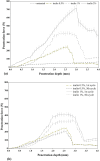

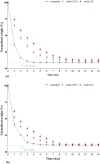




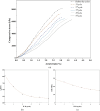

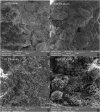
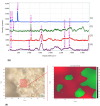

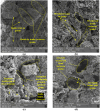
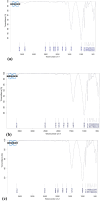

Similar articles
-
Durability, Strength, and Erosion Resistance Assessment of Lignin Biopolymer Treated Soil.Polymers (Basel). 2023 Mar 21;15(6):1556. doi: 10.3390/polym15061556. Polymers (Basel). 2023. PMID: 36987336 Free PMC article.
-
Durability against Wetting-Drying Cycles of Sustainable Biopolymer-Treated Soil.Polymers (Basel). 2022 Oct 10;14(19):4247. doi: 10.3390/polym14194247. Polymers (Basel). 2022. PMID: 36236194 Free PMC article.
-
Sustainable improvement of granite sludge dust properties using microbially induced carbonate precipitation (MICP): strength enhancement, erosion prevention, and dust mitigation.Environ Sci Pollut Res Int. 2025 Jan 4. doi: 10.1007/s11356-024-35781-7. Online ahead of print. Environ Sci Pollut Res Int. 2025. PMID: 39754623
-
Influence of biopolymer-vegetation interaction on soil hydro-mechanical properties under climate change: A review.Sci Total Environ. 2024 Dec 1;954:176535. doi: 10.1016/j.scitotenv.2024.176535. Epub 2024 Sep 25. Sci Total Environ. 2024. PMID: 39332716 Review.
-
A state-of-the-art review on the application of lignosulfonate as a green alternative in soil stabilization.Sci Total Environ. 2024 Sep 15;943:173500. doi: 10.1016/j.scitotenv.2024.173500. Epub 2024 May 28. Sci Total Environ. 2024. PMID: 38815820 Review.
Cited by
-
Non-ureolytic EICP as a novel enzymatic pathway for sustainable soil stabilization.Sci Rep. 2025 Aug 1;15(1):28150. doi: 10.1038/s41598-025-13525-y. Sci Rep. 2025. PMID: 40750649 Free PMC article.
References
-
- Bongaarts, J. & O’Neill, B. C. Global warming policy: Is population left out in the cold?. Science361, 650–652. 10.1126/science.aat8680 (2018). - PubMed
-
- Chu, J. & Guo, W. Land reclamation using clay slurry or in deep water: challenges and solutions. Jpn. Geotech. Soc. Spec. Publ.2, 1790–1793. 10.3208/jgssp.tc217-02 (2016).
-
- Hopkins, C., Cameron, D. & Rahman, M. M. Field trials of unbound granular pavements treated with an insoluble dry powdered polymer. Transp. Geotech.41, 101037. 10.1016/j.trgeo.2023.101037 (2023).
-
- Manzoor, S. O., Yousuf, A., University of Mohammed Premier Oujda Morocco. Stabilisation of soils with lime: A review. J. Mater. Environ. Sci.11, 1538–1551 (2020).
-
- Noin D, Clarke JI. Population and environment in arid regions: Paris, Pearl River, N.Y. UNESCO, Parthenon Publication Group. https://nla.gov.au/nla.cat-vn241731. (1998).
LinkOut - more resources
Full Text Sources

